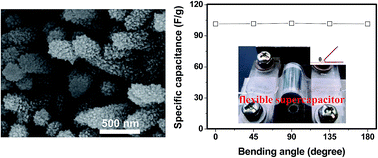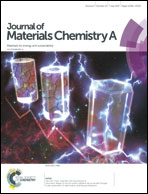Nanocellulose-mediated hybrid polyaniline electrodes for high performance flexible supercapacitors†
Abstract
Cellulose, abundant in nature, is very attractive for application in energy storage devices. Herein, cellulose nanofibers (CNF), detached from natural cellulose, are employed to fabricate flexible electrodes with polyaniline (PANI) as the active material for high performance supercapacitors. The presence of CNF in conductive composite substrates can tailor the morphology and doping of grown PANI worm-like nanorods during in situ polymerization, resulting in the improvement of specific capacitance. A maximum specific capacitance of 421.5 F g−1 is achieved for hybrid PANI electrodes based on composite substrates with 20 wt% CNF loading at a current density of 1 A g−1. Moreover, good rate capability and energy/power density balance are exhibited by the hybrid PANI electrodes. All-solid-state supercapacitors assembled from the hybrid PANI electrodes show excellent electrochemical performance and capacitance retention under repeated bending over 1000 cycles due to the mechanical flexibility of composite substrates with CNF as binders. This research provides a facile route to fabricate high performance flexible supercapacitors from bio-sourced CNF and low-cost PANI.



 Please wait while we load your content...
Please wait while we load your content...